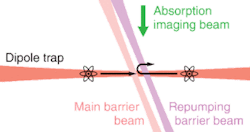The hypothetical Maxwell’s demon opens and closes a tiny trapdoor dividing two containers of gas to shuttle atoms one way without exerting effort, raising the number of atoms in one container and lowering it in the other, apparently in violation of the second law of thermodynamics. Researchers at the University of Oregon (Eugene, OR) have created a Maxwell’s demon using an asymmetric optical potential barrier—although, as with any practical realization of such a demon, further investigation shows that the second law is always conserved.
Approximately 3 × 104 rubidium (87Rb) atoms at about 30 µK from a standard six-beam magneto-optic trap are loaded into a dipole trap, which has a 9.3 W beam from a 1090 nm fiber laser focused to a 31 µm waist. Two additional beams separated by 34 µm form the one-way barrier; the main beam is stabilized on a dip in the 85Rb saturated-absorption spectrum, which is at a frequency 1.16 GHz higher than that of the other (repumping) beam. After 100 ms, most of the atoms end up on one side of the trap; however, the spontaneous scattering of a barrier photon in each “trap-door” interaction carries away entropy, conserving the second law. Contact Daniel Steck at [email protected].
